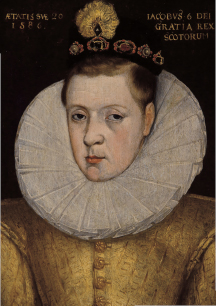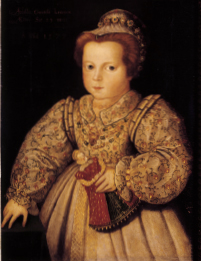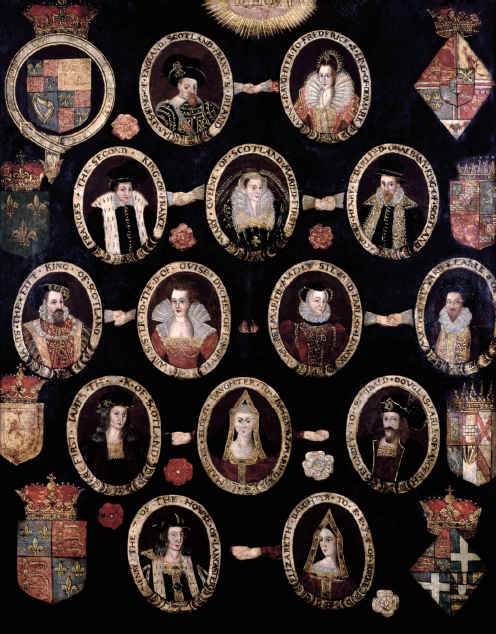Tudor (40 page)
Authors: Leanda de Lisle

James VI of Scotland, aged twenty.

The spoilt, vicious, doomed, Henry Lord Darnley â later King of Scots â and his brother Charles.


During the second week of October the young king was given the shocking news that his uncle Somerset was planning to murder Dudley and Katherine Parr's brother, William Parr. Edward promptly empowered Dudley further, by creating him Duke of Northumberland, his ally Harry Grey, Duke of Suffolk, and William Parr's brother-in-law, William Herbert, Earl of Pembroke. William Parr already had the great title of Marquess of Northampton. Five days later Edward saw his uncle arrive at court at Whitehall, noting in his diary that he was âlater than he was wont and by himself'. Edward then added the chilling comment, âAfter dinner he was apprehended.' The former Protector was returned to the Tower, and this time he would not be released. Somerset was to be executed early in the following year.
16
Mary soon found she was again being invited to court. The pretext was a reception given in November for Mary of Guise, the widow of her cousin James V, who had died in 1542. Mary declined the invitation, perhaps because she feared being asked to attend a religious service with the king. Instead, Edward's diary records that he sat on Mary of Guise's right, under a shared cloth of state, while on the other side were his cousins Frances Brandon and Margaret Douglas. Frances was often at court, because her husband, Harry Grey, was regularly at the king's side, but Margaret and her husband Lennox had also maintained cordial relations with Edward and his councillors. They were discreet about their conservative religious inclinations and Lennox was useful to Edward, running an effective network of spies in Scotland.
17
The women dressed to flatter Mary of Guise, in the Scottish style with their hair loose, âflounced and curled and double curled'.
Strikingly, the princess Elizabeth was no more present at the reception than her elder sister, Mary. But she made her presence felt when she did appear at court, by dressing so plainly that it was âto the shame of them all'.
18
Edward had recently received a work promoting modesty of dress in women, and Elizabeth was keen to remind him that, in contrast to Mary, she was the good Protestant princess her
reformist governess had raised her to be, as well as (less convincingly) modest and chaste. It did her little good. While Edward noted Lady Jane Grey's attendance at the reception, he made no mention of his half-sister's presence on any of the days when Mary of Guise was being welcomed and entertained. It seems he was not encouraged to be any closer to her than he was to Mary.
That Christmas, after Mary of Guise had left, there were further entertainments to be enjoyed at court with plays, masques, tournaments and a tilt on the last day, 6 January, which Edward enjoyed enormously. John Dudley had ensured Edward had been taught to ride and handle weapons, and Edward had begun âarming and tilting, managing horses and delighting in every sort of exercise', although he did not yet take part in the competitions.
19
Dudley was extremely astute in his handling of Edward. According to the French ambassador, Edward revered Dudley almost as if he was his father. Yet Dudley was careful to emphasise that, as Lord President of the king's council, he was only a senior member of a team working for Edward, whom he involved ever more deeply in matters of state.
In March a core of the king's senior servants began to meet with him each Tuesday to brief him on policy matters. High on the agenda was the work that was about to begin on a new and more radical prayer book, which would rename the Eucharist the Lord's Supper, have Communion tables brought into the church chancel or nave so people could stand around them as for a communal supper, and where they were given bread in their hands rather than unleavened wafers in their mouths. It would also rewrite the baptism and confirmation service, and remove all mention of prayers for the dead at burial services. Edward's cousin Margaret Douglas remained at court, but in early April there was a measles and smallpox outbreak and on 7 April she asked permission to return to Yorkshire.
20
Even Edward had fallen ill, but happily by the 12th, when Margaret was heading north, Edward was reporting that âwe have shaken that quite away', and in the summer Edward was hunting again.
That October, when Edward turned fifteen, a famous Italian astrologer was invited to cast the king's horoscope.
21
He predicted Edward would reign a further forty years and would achieve much. The revised Book of Common Prayer, published in November 1552, was to be followed by the publication of forty-two articles of faith that would become the basis for the Elizabethan thirty-nine articles that today remain the founding beliefs of the Church of England.
22
The future would not be untroubled: the country was suffering dire financial problems, stemming in part from the wars of the 1540s against France and then Scotland. Cranmer and Dudley had fallen out over the execution of Somerset and the push for a further confiscation of church assets. But the longer-term prospects were bright: it was, the astrologer assured Edward, all in the stars.
E
DWARD HAD A PERSISTENT COUGH IN
J
ANUARY 1553 THAT HE WAS
having trouble shaking off.
1
The fifteen-year-old king recalled, however, that he had had a âgrave sickness' in the summer of 1550, and both measles and smallpox in April 1552. He would surely soon recover again.
2
The cough had worsened when, on Saturday 7 February, Elizabeth wrote a letter to her brother, telling him that while on her way to see him on the Thursday, she had been stopped on the road and told he was too ill to give her an audience. She alluded to gossip that she had lost his favour. She was sure, she said, this was not true, and whatever others thought, Elizabeth noted, âyour grace's goodwill . . . I trust will stick by me'.
3
There is no record of a reply.
Mary, who had arrived in London the previous day attended by a retinue 200 strong, had been better treated than Elizabeth. John Dudley had met her on the outskirts of the city along with a number of knights and gentlemen who had escorted her to Whitehall. There she was entertained with great magnificence, and a few days later her ailing brother had agreed to see her. Edward had maintained the ban on the Mass in Mary's private chapels, despite the Imperial ambassador pleading with him âseveral times to let my sister Mary have her Mass'.
4
Whatever passed between brother and sister that February he was determined not to change his mind on this, and may have tried, unsuccessfully, to change hers. On 21 February
John Dudley called in one of her leading servants, for another dressing-down on the subject.
Edward began to feel better, at last, in April 1553 when the weather got warmer. Nevertheless, the time had come, he felt, to practise writing a will before drawing up a more formal document in the event that he should fall seriously ill again. Headed âMy Device for the Succession', his efforts covered barely more than one piece of paper, but its contents were explosive.
The first decision Edward made was to pass over the claims of his sisters, Mary and Elizabeth.
5
Dynastic issues took second place for Edward to religious ideology and, as he later admitted, he feared Mary would undo the religious reforms of his reign, not least his replacement of the Mass with the Lord's Supper and the destruction of images. Since there was no precedent for ignoring Mary's claim on grounds of her Catholic faith, he chose to use her illegitimacy under the Act of Succession of 1536 as the legal basis for his actions. With Elizabeth described as illegitimate in the same Act, it was necessary that she also be passed over. But in any case, as Edward later reminded his lawyers, Elizabeth's mother had died a traitor to his father.
6
Edward then looked to other heirs of their Tudor grandfather, Henry VII. It was said that the first Tudor king had hoped that in the event of the failure of his son's line England would look to the heirs of his daughter, Margaret of Scots. But Margaret Tudor's senior heir, Mary, Queen of Scots, was a Catholic and betrothed to the French dauphin. The next in line, Margaret Douglas, was, if not a papal Catholic, then certainly no Protestant, and her husband had been a Scot and a Frenchman before he became an Englishman. Both had been ignored in Henry VIII's will and so a precedent had also been set for ignoring them now, as Edward did. This left the heirs of his junior aunt, Henry VIII's younger sister, the French queen, and her husband, Charles Brandon.
The French queen's eldest daughter, Frances, was a staunch Protestant. But Henry's will had bypassed her in favour of her
daughters: Lady Jane, Katherine and Mary Grey. In any case, Edward wanted a male heir in line with the precedents for royal women transmitting their rights to their sons. Edward therefore left his throne to the sons Frances might yet have (she was thirty-five), followed by the sons of her daughters in line of succession. Failing the Grey line, the crown was to pass through Frances' fifteen-year-old niece, Margaret Clifford, the sole heir of Frances' younger sister, Eleanor, who had died in 1547.
7
Having written the document, it must have seemed unlikely to Edward that it would ever see the light of day, but he was not yet well.
On 11 April Edward travelled by barge from Westminster to the airy rooms of Greenwich Palace, where he hoped he would continue his recovery. Those around him had to consider, however, what would happen if he did not. Under the terms of his will the throne would be vacant until a male heir was born, with Frances acting as governor.
8
An empty throne was likely to attract the predatory attentions of the King of France, acting in favour of his future daughter-in-law, Mary, Queen of Scots, and of the emperor Charles V acting for his cousin, the princess Mary. As the Tudor claimant, and accepted as Edward's heir for a decade, the princess was by far the stronger candidate, and if she became queen there was every reason to suppose she would revenge herself on those who had bullied her for years and overthrown the Mass. To prevent her accession a male heir was needed as soon as possible, and to this end all the women of royal blood would have to be married. Even if a son wasn't born in time, the marriages could be used to bind the leading families of the regime to a common purpose: preventing Mary's accession.
